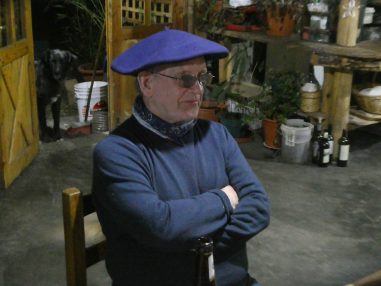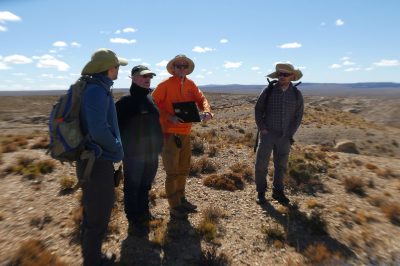A Life of Mapping Ancient Continental Margins
September 15, 2020
In 2013, after spending 41 years researching sedimentology and stratigraphy around the globe, Ronald Steel—then then a Professor and the Davis Centennial Chair in Petroleum Geology at the Jackson School—found the perfect field site: a spot five hours west of Neuquen, Argentina on the ea stern flank of the Andes. There, he and his students have spent the last seven years tracing the Jurassic rivers that flowed out onto an ancient continental margin and moved sediment into a marine delta system that was part of the evolving South American Pacific margin.
stern flank of the Andes. There, he and his students have spent the last seven years tracing the Jurassic rivers that flowed out onto an ancient continental margin and moved sediment into a marine delta system that was part of the evolving South American Pacific margin.
“This is one of about three places in the world where you can really ‘walk out’ across the ancient continental margin—the shelf, the continental slope, and the deep-water submarine fans —because it is now uplifted, well above the water,” said Steel.
Steel joined the Jackson School in 2003, holding the Davis Centennial Chair in Petroleum Geology, and was the Chair of the Department of Geological Sciences from 2011-2015. This June, he retired with emeritus status.
But that does not mean that his work will stop. Far from it.
“One of the things that happens when you begin to write papers is that you discover that you are missing information. Sooo… we are returning soon to this really beautiful area,” he added with elongated vowels hinting at his Scottish heritage.
Steel grew up in Glasgow and attended that city’s university for both his undergraduate (1967) and graduate (1972) degrees. His expertise as a sedimentary geologist garnered him positions in both academia and industry, and he has received numerous honors and distinctions, including the 2016 Twenhofel Medal for ‘Outstanding Contributions to Sedimentary Geology’ from the Society for Sedimentary Geology.
And even though his career spanned a half century, his research output has been exceptionally high—260 papers and 11 books—and impactful with nearly 18,000 citations and eight “best paper or poster” awards. Steel is quick to point out that his many graduate students helped create this legacy; in total, he has supervised over 200 from the University of Bergen, the University of Wyoming, and UT Austin. In fact, Steel continues to bestow his abundant energy and knowledge of sequence stratigraphy on students through special courses in Asia, the Middle East and Europe. Just before retiring this year and in response to COVID-19, he taught an online class for the University of Petroleum in Beijing.
“It was pretty hard work, I can tell you,” said Steel. “Teaching students over Zoom for 32 hours is challenging and a little bit impersonal.”
How did you first get interested in geology?
You’re asking me that, huh [laughs]? My grandfather was a McLeod of Raasay, and when I was  young we would spend the summers in an old stone cottage on the Island of Raasay that we’d inherited. The geology there is really well laid out on the landscape of th
young we would spend the summers in an old stone cottage on the Island of Raasay that we’d inherited. The geology there is really well laid out on the landscape of th
e island, and I would run across students and professors making maps and looking at rocks. Sooo, I became a geologist by wandering around, meeting people, and wondering what they were doing with a hammer and a notebook and a map.
How did you get started with research?
By graduate school, I was a pretty active walker and climber, so I decided to research a particular time interval—the Triassic about 200 million years ago—represented by red-colored rocks on the Hebridean islands of Western Scotland. I was probably the first person to sew together all of the bits and pieces of the non-marine Triassic rifted basins of northwest Britain into a more coherent paleo-geographic map.
What was your academic path?
I got a teaching assistant position at the University of Manchester for two years until I got wind of an opening at the University of Bergen to train students in sedimentary geology. Oil activity in the North Sea was just beginning, and Norway—mainly old basement bedrock—was short of the right kind of geologists for the new petroleum industry. The famous story is that, just before oil was discovered in the late 1960s, the director of the Geological Survey of Norway said he would drink all the oil anyone would find in the North Sea. Sooo, I’m not sure what happened to him [laughs]. I moved from post-doc to became a lecturer at the University of Bergen and for ten years helped to supply the oil industry with bright young geologists.
I stayed in Norway but moved to an oil company, Norsk Hydro. It was like heaven: it was the only way for me to get my hands on the new exciting marine geology of offshore Norway, I needed access to the well, core and seismic data to get into the exciting new North Sea and NE Atlantic margin geology. Over the next nine years I became their Chief Geologist, but I was being shunted up into administrative positions and was missing the technical side of geology. Sooo, I decided to say quits on that and went back to academia in 1990, to the University of Bergen again. Because I now knew the oil and gas language, I was able to access funding from Industry for research and graduate student projects!
Why the focus on marine rocks?
From my Norwegian Shelf work I became very interested in how continental shelves arise globally and in the sequence stratigraphy made by sea level change, tectonics and climate over time. When sea level is low, the shoreline and rivers move to the edge of the continental shelf, dumping sediment into deep water on the continental slope. The sandy accumulations at the bottom of these slopes became the biggest reservoirs of oil and gas in the world, but were not always easy to predict. To find out where these piles of sand are exactly, you need to know the size of the ancient rivers, where they were positioned geographically, and whether or not strong storm waves were moving the sediment far alongshore before they were dumped out onto the continental slope.
Why did you move to the U.S.?
In 1995 I got an invitation to apply for a position at The University of Wyoming as their first endowed chair, the Wold Chair. I stayed there from 1995 until 2003 when I came to The University of Texas at Austin.
But there was a research angle too. With Norwegian students, I had already begun to work in the Rocky Mountains on marine rocks from Western Interior Seaway, the shallow sea that stretched from Texas to Canada during the Cretaceous. I was interested in the very strong tides that developed within this seaway and spent much of my time looking at rocks between the Book Cliffs in Utah and Rock Springs Uplift in Wyoming. The ocean tidal wave, initially modest in amplitude, would enter the seaway from the Gulf of Mexico and suffer resonant amplification at certain critical distances on the shelf. Tides also became enhanced because of constriction on entering the mouths of rivers, but the tidal signals are sometimes easily destroyed by shoreline waves. We measure grain size, bed thickness and sedimentary structures within the Cretaceous seaway rock succession to be able to reconstruct the river currents, waves and tidal currents in the seaway. These three things are interacting to mold the entire landscape at the coast and the shelf seascape.
 What are you working on right now?
What are you working on right now?
For the last 10 years, my research team became interested in larger-scale continental margins. This took us to the Jurassic Pacific margin of western Argentina, the South China Sea Neogene margin, and the Caribbean Orinoco margin of eastern Venezuela and the island of Trinidad. In the late Miocene through Pleistocene, the Orinoco River built a wide Atlantic continental shelf. Trinidad is part of this shelf, but tectonics and fault movements raised the island up so that we can now examine the whole the shelf that had been in the deep Atlantic. One of the most exciting things we discovered in the Orinoco stratigraphy is that huge amounts of mud were mixing with the Orinoco sediments at and around the Pliocene river mouth. We really didn’t really know where the mud was coming from, but we discovered that even today it was being carried northward by shelf currents from more than a thousand miles away, from the mouth of the Amazon River [laughs].
What do you enjoy outside of geology?
Nothing very ambitions. I like swimming. I like hiking. My wife and I like to go camping a lot…in fact, we are going out to McKinney Falls State Park shortly. Otherwise, I like traveling, especially in South America and China. It is a great eye-opener to visit other countries and see how things work differently—sometimes worse, sometimes better.
A shorter version of this story will appear in the Fall 2020 Jackson School Newsletter. Written by Kristin Phillips, Department of Geological Sciences